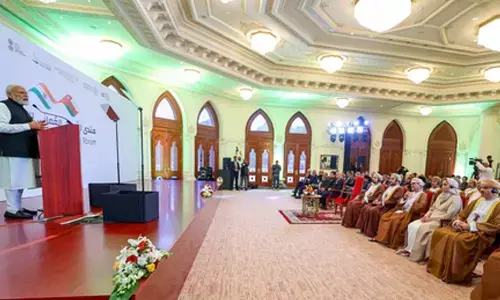Beating the heat: How Bharat’s ancient architecture can cool us down today

Explore how Bharat’s ancient architectural wisdom offers innovative solutions to beat the heat in contemporary buildings. Delve into the fusion of traditional techniques with modern design principles for sustainable and comfortable living spaces
Contemporary architecture faces several challenges when it comes to dealing with heatwaves. Concrete structures, with their high thermal mass, tend to retain heat, making indoor spaces uncomfortably hot. Limited natural ventilation and the urban heat island effect further exacerbate the problem. Cooling these structures consumes a lot of energy, contributing to environmental degradation and climate change. Additionally, elevated indoor temperatures pose health risks, particularly for vulnerable populations.
Ancient architecture offers valuable lessons for creating comfortable and sustainable buildings in our hot climate. By harnessing nature’s power, ancient architecture can create homes that naturally cool themselves. Key elements include the courtyard, high ceilings, and strategically placed windcatchers (jalis) that channel cool air into the building. Water plays a vital role in cooling the surrounding air through evaporation, and buildings often use thick walls made of local materials like brick and terracotta.
Previously, houses with rainwater soak pits were designed to collect rainwater efficiently and recharge groundwater. These houses had sloping roofs to collect rainwater, and adjacent soak pits lined with permeable materials to store and infiltrate the water into the ground. This provided a sustainable source of water for communities in water-scarce environments. Contemporary Bharat’s architecture is a blend of modern design principles and traditional elements, drawing inspiration from ancient Indian architecture. However, there are notable differences between ancient and contemporary architecture. Ancient architecture used materials like stone, brick, and wood, while contemporary architecture often uses concrete, glass, and steel due to their availability, strength, and ease of construction. The design philosophy of ancient architecture focused on harmony with nature, spiritual symbolism, and community integration, while contemporary architecture leans towards functionality, sustainability, and individualism.
Modern architects can integrate these principles into contemporary designs, such as reimagining courtyards as light wells or atriums in multi-story buildings, mimicking the function of jalis with louvers and operable windows. Water features can be incorporated for aesthetics and cooling effects.
The benefits of these techniques extend beyond just beating the heat. By relying less on air conditioning, we can significantly reduce our energy consumption, lowering our carbon footprint and saving on electricity bills. These designs often promote natural lighting and improved air quality, contributing to a healthier and more comfortable living environment. In a world grappling with climate change and rising energy demands, ancient Indian architecture offers a beacon of hope. By embracing the wisdom of the past and adapting it for the present, we can create buildings that are not only comfortable but also sustainable. In terms of scale and function, ancient architecture emphasized grandeur and religious significance, while contemporary architecture focuses on more versatile spaces catering to diverse functions and user needs. Technology and innovation in contemporary architecture allows for innovative structural designs, sustainable practices, and efficient construction methods.
As urbanization and globalization continue, contemporary Indian architecture faces challenges related to urban sprawl, environmental degradation, and cultural homogenization. Balancing modernization with preservation of cultural identity and heritage is a key concern. Some potential issues in contemporary architecture include loss of identity, overemphasis on commercialization, neglect of sustainability, lack of integration with context, and inadequate planning and infrastructure. To address these challenges, a holistic approach that balances modernity with tradition, prioritizes sustainability and cultural heritage, involves community participation, and promotes responsible urban development practices is needed.
Auroville, a township in Tamil Nadu, uses stabilized compressed earth blocks (SCEBs) for affordable single-family homes, showcasing the beauty and practicality of earthen construction. These blocks provide excellent thermal insulation, keeping interiors cool naturally. Bamboo, abundant in India’s northeastern states, is a game-changer in housing projects due to its strength, lightweightness, and quick growth, making it a sustainable and affordable alternative to traditional building materials.
Ancient architectural features and structures have proven to be resilient to natural disasters. These include earthquake resistance, flood management, heat and sun protection, and fire resistance. The Konark Sun Temple in Odisha, known for its intricately carved stone wheels and interlocking joints, provides stability during earthquakes. The Chennakesava Temple in Karnataka, known for its Hoysala architecture, is renowned for its flexibility and structural elements. The Harappan city of Mohenjo-Daro uses advanced urban planning and drainage systems to mitigate flooding from the Indus River. Stepwells in Gujarat and Rajasthan, like the Rani ki Vav in Patan, store water during the monsoon season and prevent flooding. The 800-year-old Ramappa temple of Telangana state with wet sand technology and floating bricks with marvelous architectural expertise.
The Shore Temple in Mamallapuram, Tamil Nadu, uses Pallava architecture with sturdy stone construction and sloping roofs to withstand coastal winds and cyclones. Chhatris in Rajasthan feature domed pavilions and wind-catching structures that provide shelter from strong winds while allowing natural ventilation. Kerala architecture features steep sloping roofs, extended eaves, and ventilated courtyards to promote airflow and mitigate heat in the humid tropical climate. Monsoon management involves deep stepwells like Chand Baori in Abhaneri, Rajasthan, and traditional wooden houses in Assam using lightweight and easily replaceable roofing materials. Fire resistance is also evident in temples like Khajuraho in Madhya Pradesh, built using durable sandstone and granite.
Ancient architecture offers passive cooling techniques for a more comfortable living experience. By leveraging these principles, affordable housing can be made more achievable. Ancient Indian construction relied on local and natural materials like earth, bamboo, and stone, which eliminates high costs associated with long-distance transportation and requires less processing than modern materials like steel and concrete. Earthen construction offers excellent thermal regulation and can be surprisingly durable. Traditional building techniques in India often relied on skilled labor, minimizing the need for complex construction methods and specialized equipment. This approach can benefit affordable housing projects by reducing overall labor costs. Smart space planning and modular design can be used in ancient Indian architecture, maximizing usable space and minimizing unnecessary square footage. Courtyards can also serve as multifunctional spaces, reducing the need for dedicated rooms. Prefabricated components can streamline construction and reduce waste, particularly beneficial for large-scale affordable housing projects. Passive cooling techniques in buildings require less reliance on energy-intensive air conditioning, leading to significant savings on utility bills for residents. The use of durable and locally-sourced materials also translates to lower maintenance costs. By combining ancient architecture principles with modern technology, affordable housing solutions can be created that are not only cost-effective but also environmentally friendly and comfortable, contributing to a more sustainable future for cities.

















